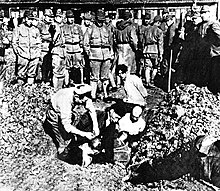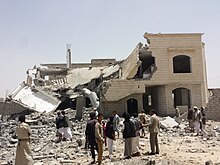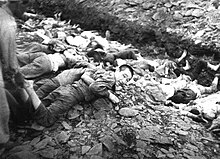War crime
A war crime is a violation of the protections established by the laws and customs of war, made up of serious violations of International Humanitarian Law committed in an armed conflict and violations of the International right. The term is largely defined in international law, including the Geneva convention. Mistreatment of prisoners of war, civilians and genocide are considered war crimes.
On September 10, 2019, the International Criminal Court began to function in The Hague, with the purpose of prosecuting war crimes committed after that date. This court, established by the Rome Statute, considers war crimes among the crimes to be prosecuted in its article 5. Within the definition that the same Statute contemplates, in its article 8, the following are indicated among them:
- Violation of the Geneva Conventions of 12 August 1949;
- Violation of existing war laws, both national and international; and
- Violation of the customs of the applicable war.
In more detail they are as follows:
- Murder, ill-treatment or deportation to force forced labour on the civilian population of the occupied territories
- Murder or ill-treatment of prisoners of war or shipwrecks
- Taking and carrying out hostages
- The pillage of public or private property
- The destruction of cities and towns
- The devastation not justified by military necessity
The first heads of state or government accused of war crimes were former Japanese Prime Minister Hideki Tōjō (in 1946, as part of the Tokyo Trials) and former Yugoslav President Slobodan Milošević (in 2002 by order of the International Criminal Tribunal for the former Yugoslavia).
History
Early Examples
In 1474, the first war crime trial was that of Peter von Hagenbach, conducted by an ad hoc tribunal of the Holy Roman Empire, for his command responsibility for the actions of his soldiers, since " it was considered that he, as a gentleman, had a duty to prevent" the criminal behavior of a military force. Despite having argued that he had obeyed superior orders, von Hagenbach was sentenced to death, and beheaded.
The Hague Conventions
The Hague Conventions were international treaties negotiated at the First and Second Peace Conferences in The Hague, Netherlands, in 1899 and 1907, respectively, and were, along with the Geneva Conventions, among the first formal declarations of the laws of war and war crimes in the nascent body of secular international law.
Geneva Conventions
The Geneva Conventions are four interrelated treaties, adopted and continuously expanded from 1864 to 1949, which represent a legal basis and framework for the conduct of war under international law. At present, all member states of the United Nations have ratified the Conventions, which are universally accepted as customary international law, applicable to all situations of armed conflict in the world. However, the Additional Protocols to the Geneva Conventions, adopted in 1977, which contain the most relevant, detailed and comprehensive protections of international humanitarian law for persons and objects in modern warfare, have yet to be ratified by several States that are continually involved in armed conflicts, namely the United States, Israel, India, Pakistan, Iraq, and Iran, among others. Consequently, States retain different codes and values regarding conduct in times of war. Some signatories have systematically violated the Geneva Conventions in a way that uses ambiguities in the law or political maneuvering to circumvent the formalities and principles of the laws.
The first three Conventions have been revised and expanded, and the fourth was added in 1949:
- The First Geneva Convention to alleviate the fate of the wounded and the sick of the armed forces in the campaign was adopted in 1864 and then revised significantly and replaced by the 1906 version, the 1929 version, and then the First Geneva Convention of 1949.
- The Second Geneva Convention to alleviate the fate of the wounded, the sick and the shipwrecks of the armed forces at sea was adopted in 1906 and then revised significantly and replaced by the Second Geneva Convention of 1949.
- The Third Geneva Convention concerning the treatment of prisoners of war was adopted in 1929 and then significantly revised and replaced by the Third Geneva Convention of 1949.
- The Fourth Geneva Convention Protection of Civilian Persons in Time of War was adopted for the first time in 1949, based on parts of the 1907 Hague Convention.
In 1977 two Additional Protocols were adopted and the third was added in 2005, completing and updating the Geneva Conventions:
- Protocol I (1977) on the protection of victims of international armed conflict.
- Protocol II (1977) "relative to the protection of victims of armed conflicts without an international character".
- Protocol III (2005) concerning the adoption of an additional distinctive sign.
The Leipzig Trials
Just after World War I, the world's governments began trying to create a systematic code to define War Crimes. His first draft of the law was "Instructions to the Government of the Armies of the United States in the Field" - also known as the "Lieber Code". A small number of German World War I servicemen were tried in 1921 by the German Supreme Court for alleged war crimes.
London Charter / Nuremberg Trials 1945
The modern concept of a war crime developed under the auspices of the Nuremberg Trials based on the definition in the London Charter which was published on August 8, 1945. (See also Nuremberg Principles.) Along with the war crimes, the Charter also defined crimes against peace and crimes against humanity, which are often committed during wars and in concert with war crimes.
International Military Tribunal for the Far East 1946
Also known as the Tokyo Trial, the Tokyo War Crimes Tribunal or simply as the Tribunal, it was convened on May 3, 1946 to try the leaders of the Empire of Japan for three types of crimes: &# 34;Class A" (crimes against peace), "Class B" (war crimes) and "Class C" (crimes against humanity), committed during World War II.
International Criminal Court 2002
On July 1, 2002, the International Criminal Court, a treaty-based court based in The Hague, became operational for the prosecution of war crimes committed since that date. Several countries, most notably the United States, China, Russia and Israel, have criticized the court. The United States continues to participate as an observer. Article 12 of the Rome Statute establishes jurisdiction over citizens of non-contracting States if they are accused of committing crimes in the territory of one of the States parties.
War crimes are defined in the statute that established the International Criminal Court, which includes:
- Serious violations of the Geneva Conventions, such as:
- Deliberate killing, or causing great suffering or serious damage to the body or health
- Torture or inhuman treatment
- Illegal and free destruction or appropriation of property
- Force a prisoner of war to serve in the forces of hostile power
- Privar a prisoner of war of a fair trial
- Deport, confiscate or transfer illegally to the population
- Take hostages
- Conducting attacks against civilians
- Conducting attacks on humanitarian workers or UN peacekeepers
- Killing a surrendered fighter
- Unduly use a truce flag
- Settlement of occupied territory
- Deportation of the inhabitants of the occupied territory
- Use of poison weapons
- Use of civilians as shields
- Use child soldiers
- Shoot a combat doctor with clear badges.
- The following acts as part of a non-international conflict:
- Murder, cruel or degrading treatment and torture
- Conducting attacks against civilians, humanitarian workers or UN peacekeepers
- The following acts as part of an international conflict
- Taking hostages
- Summary performance
- Pillage
- Rape, sexual slavery, forced prostitution or forced pregnancy
However, the court only has jurisdiction over these crimes when they are "part of a plan or policy or as part of a large-scale commission of such crimes".
Legality of civilian casualties
Under the Law of Armed Conflict (LOAC), the killing of non-combatants is not necessarily a violation; many things have to be taken into account. Civilians cannot be the object of an attack, but the death/injury of civilians while carrying out an attack on a military objective is governed by principles such as proportionality and military necessity and may be permissible. Military necessity "allows for the destruction of the lives of... people whose destruction is incidentally unavoidable by the armed conflicts of war;...does not allow the killing of innocent inhabitants for the purpose of revenge or the satisfaction of a desire to kill. The destruction of property to be lawful must be imperatively required by the needs of war".
For example, carrying out an operation on an ammunition depot or a terrorist training camp would not be prohibited because a farmer is plowing a field in the area; the farmer is not the object of attack and operations would be limited to proportionality and military necessity. Instead, an extraordinary military advantage would be required to justify an operation that risks death or collateral injury to thousands of civilians. In the "grayer" cases, the legal question of whether the anticipated incidental damage is excessive can be highly subjective. For this reason, States have chosen to apply a "clearly excessive" to determine if a criminal violation has occurred.
When there is no justification for military action, such as targeting civilians, a proportionality analysis is not necessary to conclude that the attack is unlawful.
International Criminal Tribunal for the former Yugoslavia
In the case of air strikes, pilots generally have to rely on information supplied by external sources (headquarters, ground troops) that a specific position is in fact a military objective. In the case of the former Yugoslavia, NATO pilots hit a civilian object (the US bombing of the Chinese embassy in Belgrade) that had no military significance, but the pilots had no idea of determining it apart from their orders. The commission ruled that "the aircrew involved in the attack should not be held responsible for the fact that they were given the wrong target and that it is inappropriate to attempt to place criminal responsibility for the incident on senior officers for the misinformation was provided to them by officials of another agency". inviting the conclusion that crimes had therefore been committed. Collateral casualties to civilians and collateral damage to civilian objects can occur for a variety of reasons"
Rendulic's Rule
The Rendulic Rule is a standard by which commanders are judged.
German General Lothar Rendulic was accused of ordering the extensive destruction of civilian buildings and land while withdrawing from an alleged enemy attack in what is called a scorched-earth policy for the military purpose of denying enemy use of the land. German troops withdrawing from Finnish Lapland believed that Finland would be occupied by Soviet troops and destroyed many settlements while retreating to Norway under Rendulic's command. He overestimated the perceived risk but argued that the Hague IV Convention authorized destruction because it was necessary for war. He was acquitted of that accusation.
Under the 'Rendulic Rule', people must assess the military necessity of an action based on the information available to them at the time; they cannot be judged based on information that comes to light later.
Contenido relacionado
Chen Shui-bian
Serbia and Montenegro
Murcia Province








